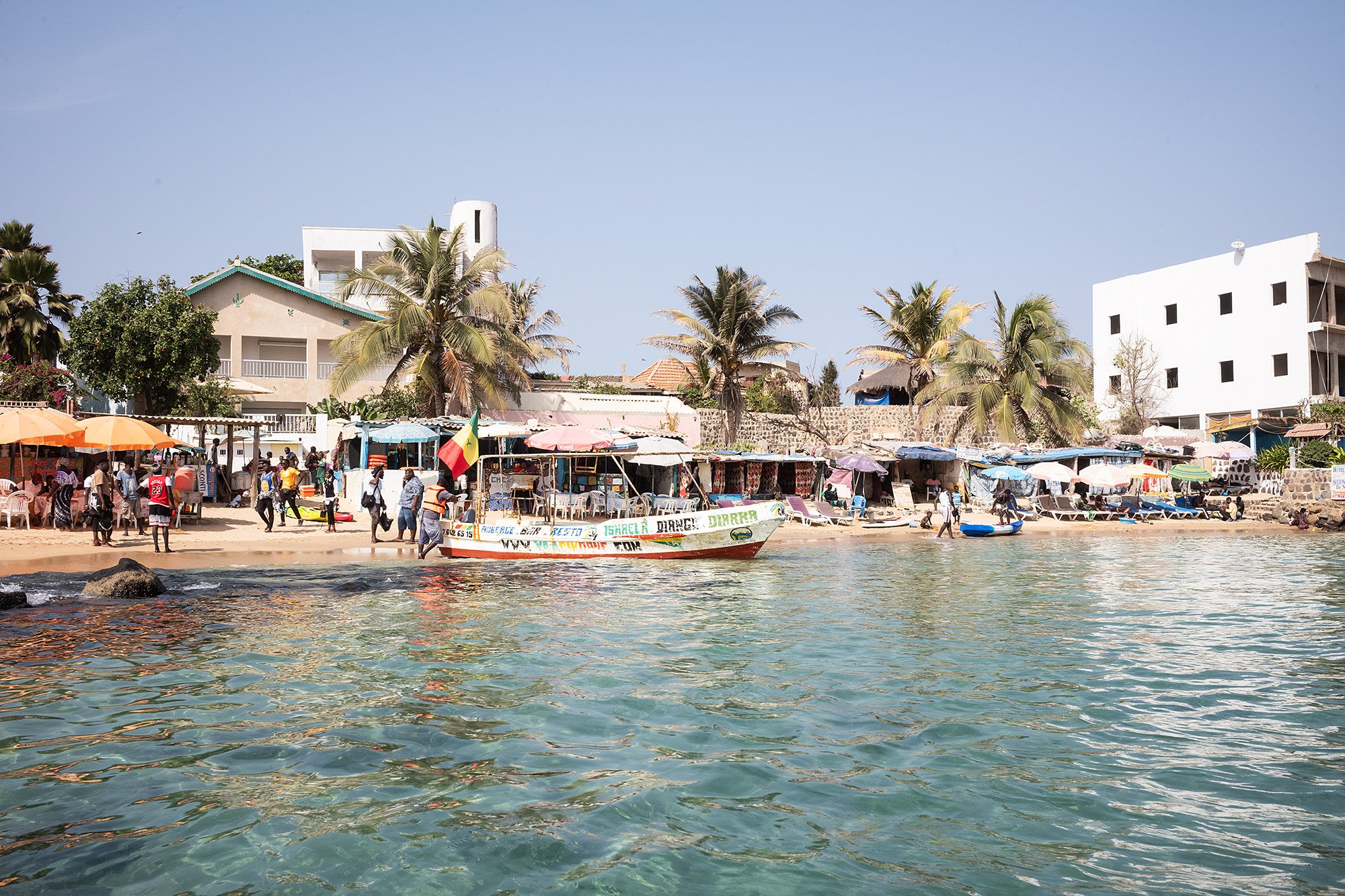
Senegal coda
A Saturday afternoon on L’île de Ngor.
It’s my last Saturday in Dakar and I decide to make the trip to L’île de Ngor, a small island off the northwest coast of the city. It’s the last tourist destination I have on my list, and it’s a beautiful day for a boat trip.
I take a Yango to the jumping-off point; the driver drops me off in a large parking lot flanked with seafood restaurants. He points to a narrow alley and I can see the beach and the sea beyond.
A fisherman approaches me as soon as I step foot on the beach. He asks if I want to go to the island; he has a boat, he can guide. I thank him and tell him I’m just here to hang out and walk down the beach, looking for the public boat.
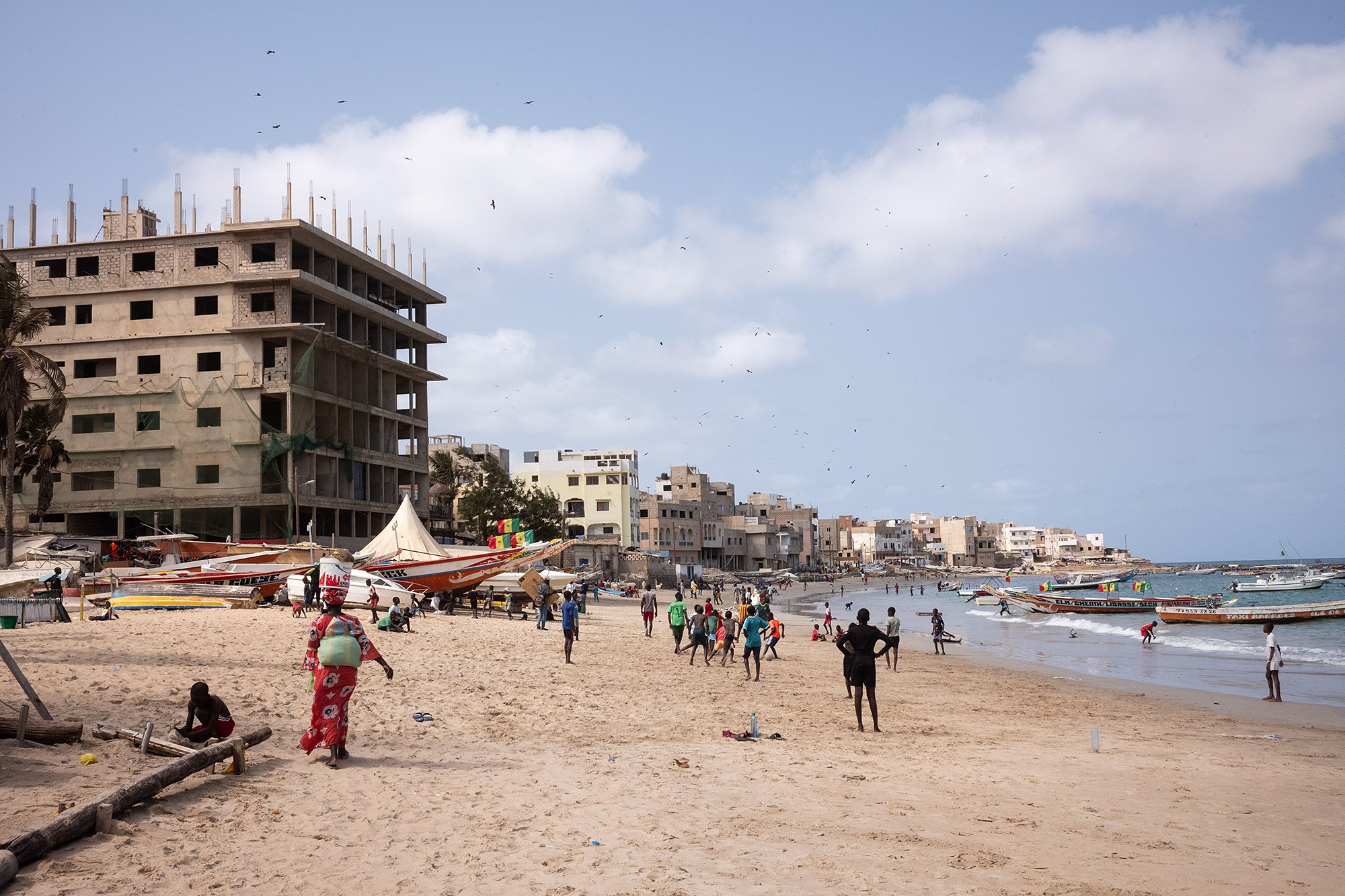
Soon I come across a small stand. A man sells passage. Round trip it’s 5,000 francs to take the ‘tourist’ boat; 1,000 for the local. The tourist boat is smaller, made of fiberglass, and easier to board; the local is a large wooden pirogue. Multiple Senegalese flags fly off the bulwark. You have to clamber over the sides to get in. I opt for the local.
I’m handed a blue life jacket and told to wait. The tourist boat comes and goes and soon I see people handling the local boat. They manhandle it off the beach and I join a group of locals and wade into the water to hoist ourselves on board.
The trip takes less than ten minutes. On the other side, we walk to the bow of the boat before jumping off onto the beach. I follow a small group and walk the length of the small beach to the west, past a string of restaurants and hotels. At the far end a man approaches me and asks if I’m hungry. He shows me a menu. There’s thiéboudieune on the menu, something I’ve been wanting to try. I tell him I’m going to take a walk around the island but I’ll keep them in mind.
I follow a small alley as it leads inland. the streets are sandy and palm-lined. Painted doors punctuate concrete and stone walls, ostensibly opening up to courtyards inside. A woman watches as a take a photo of a door down a side street. She asks me if I want to take a photo of her dog. I look at her dog; he seems uninterested.

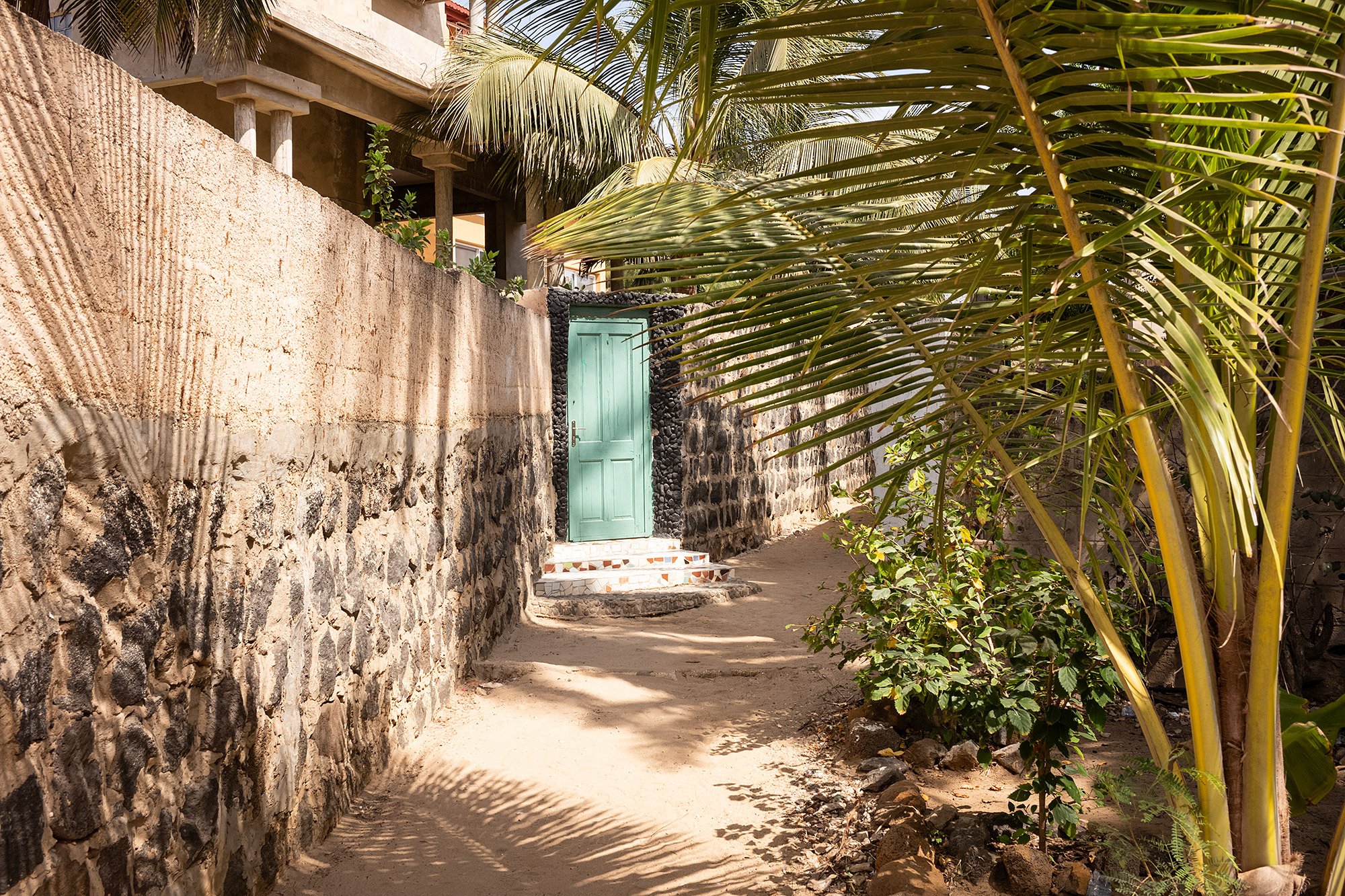
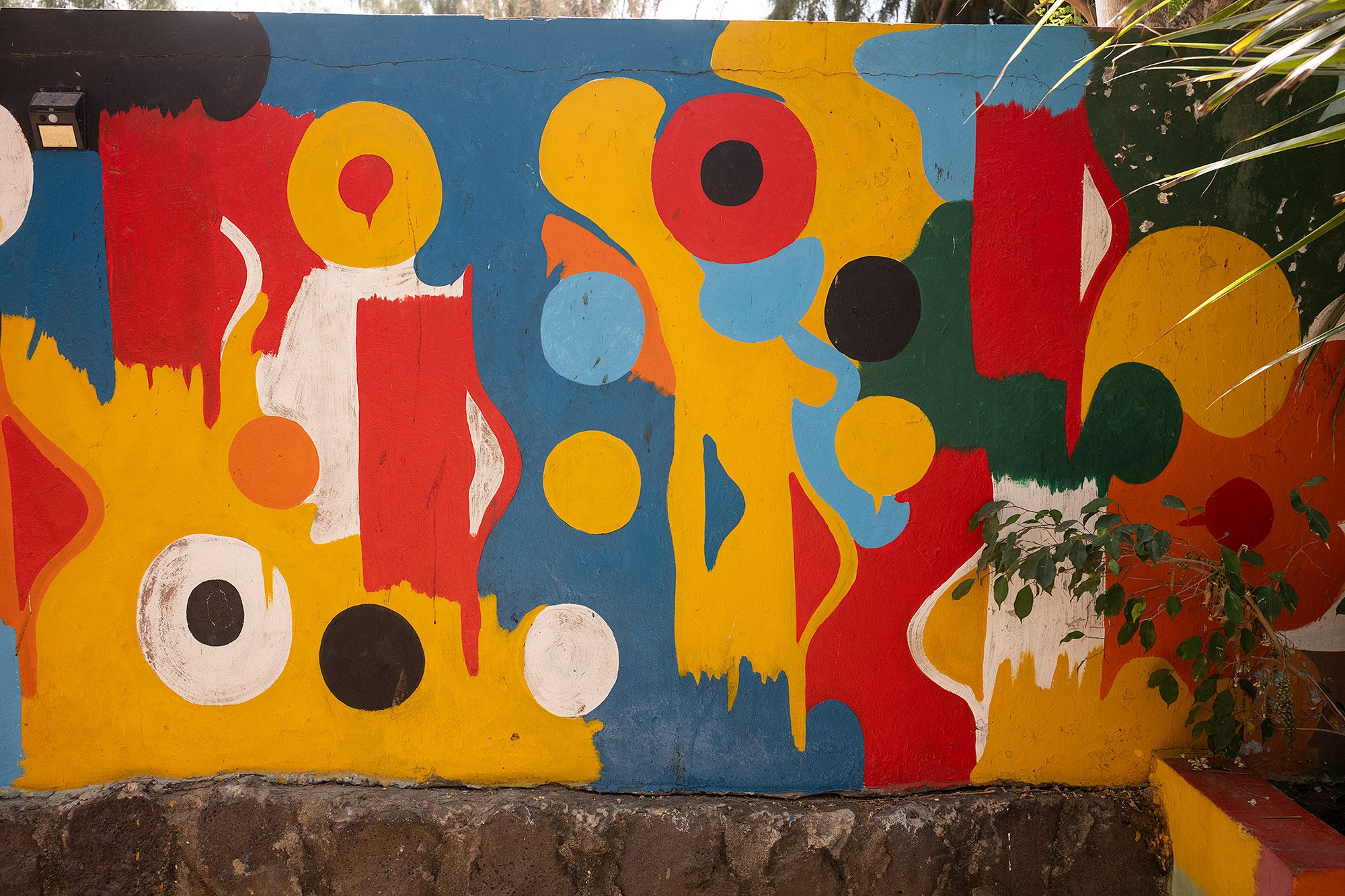

Towards the western end of the island a large black and white mural adorns the side of a building. It’s a gallery of artists and activists near and far. A doorway opens into a gallery.

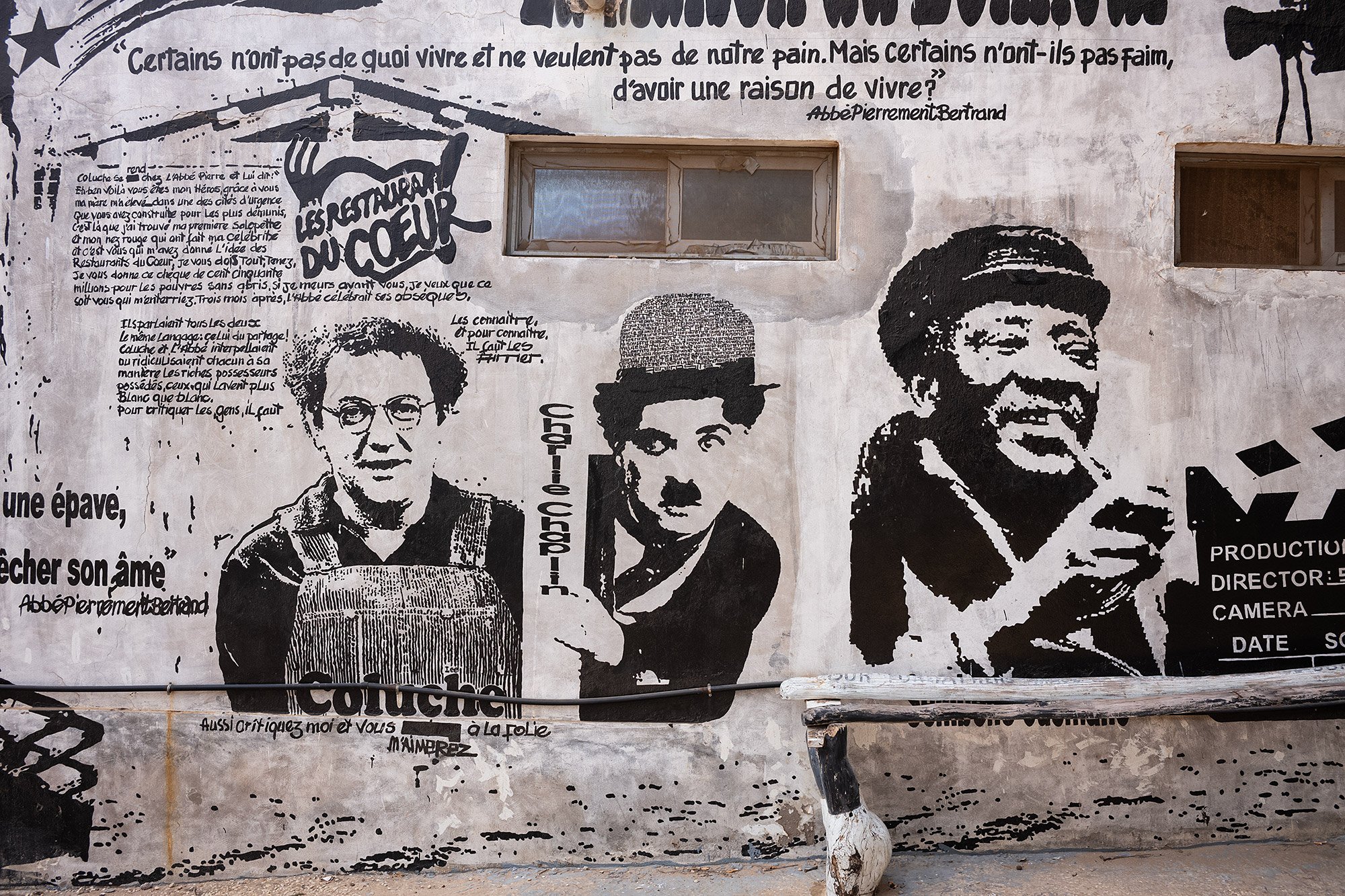
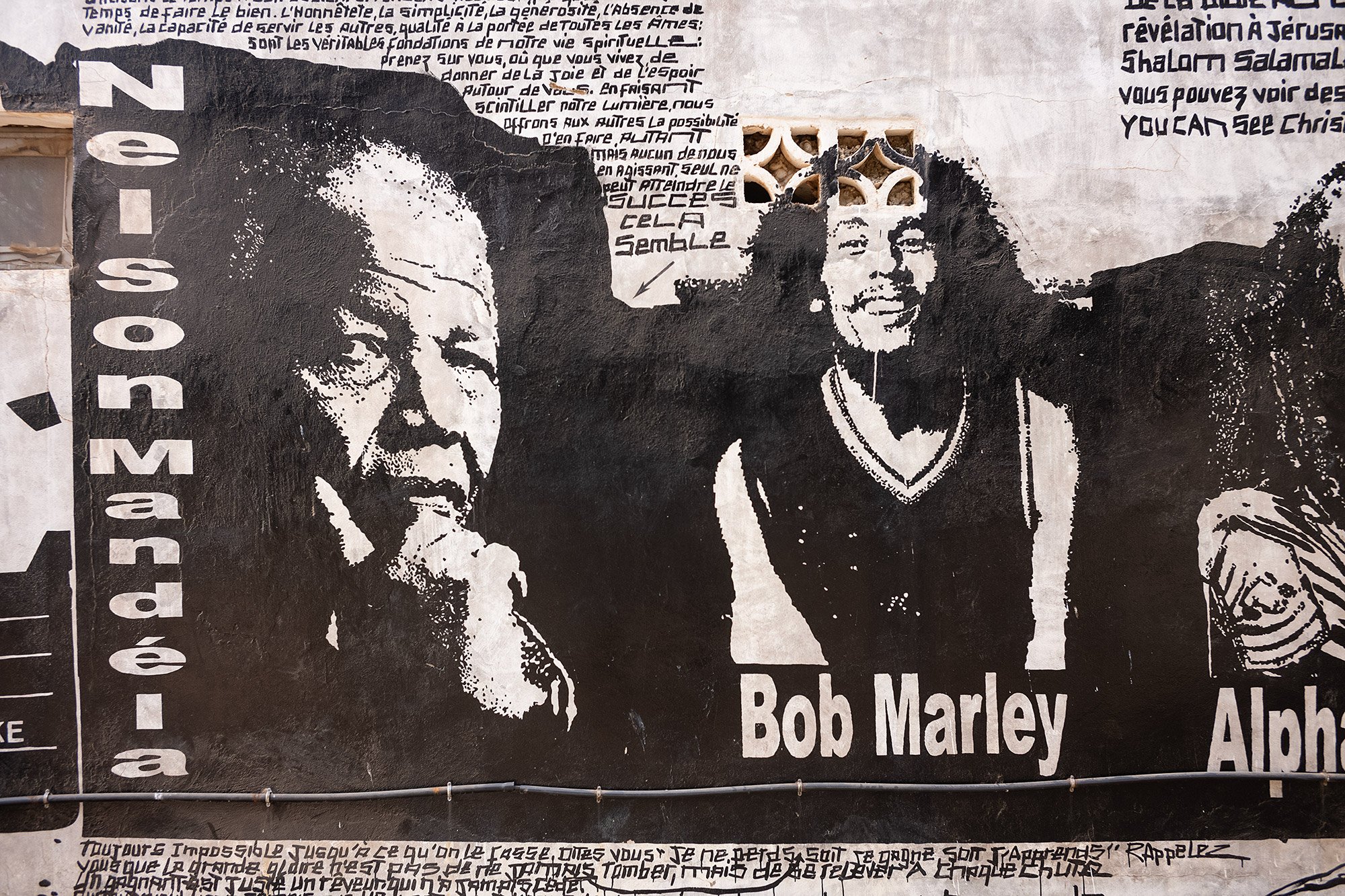
Just beyond some street art pokes out from a corner and I walk down an otherwise non-descript alley to take a look. As I stop to take photos a woman and her child pass and continue towards the western edge of the island. It’s where I’m headed and I slowly follow them down the street.
A man introduces himself as Omar the businessman. He has an array of shirts he’s printed hanging on the walls lining the street. He asks me to take a look and I do. He’s also stopped a Frenchman and as I move on they continue their conversation in French.
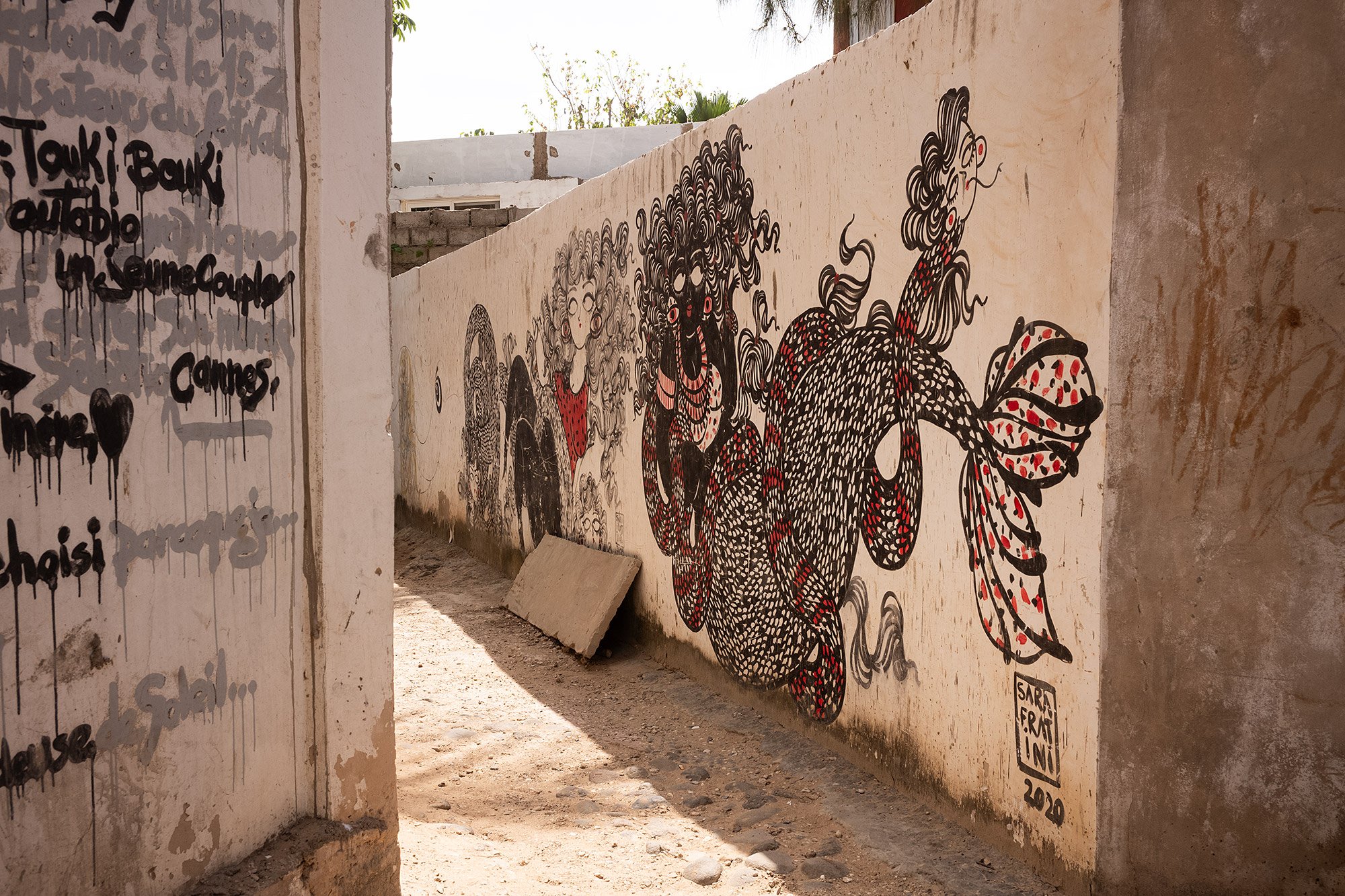
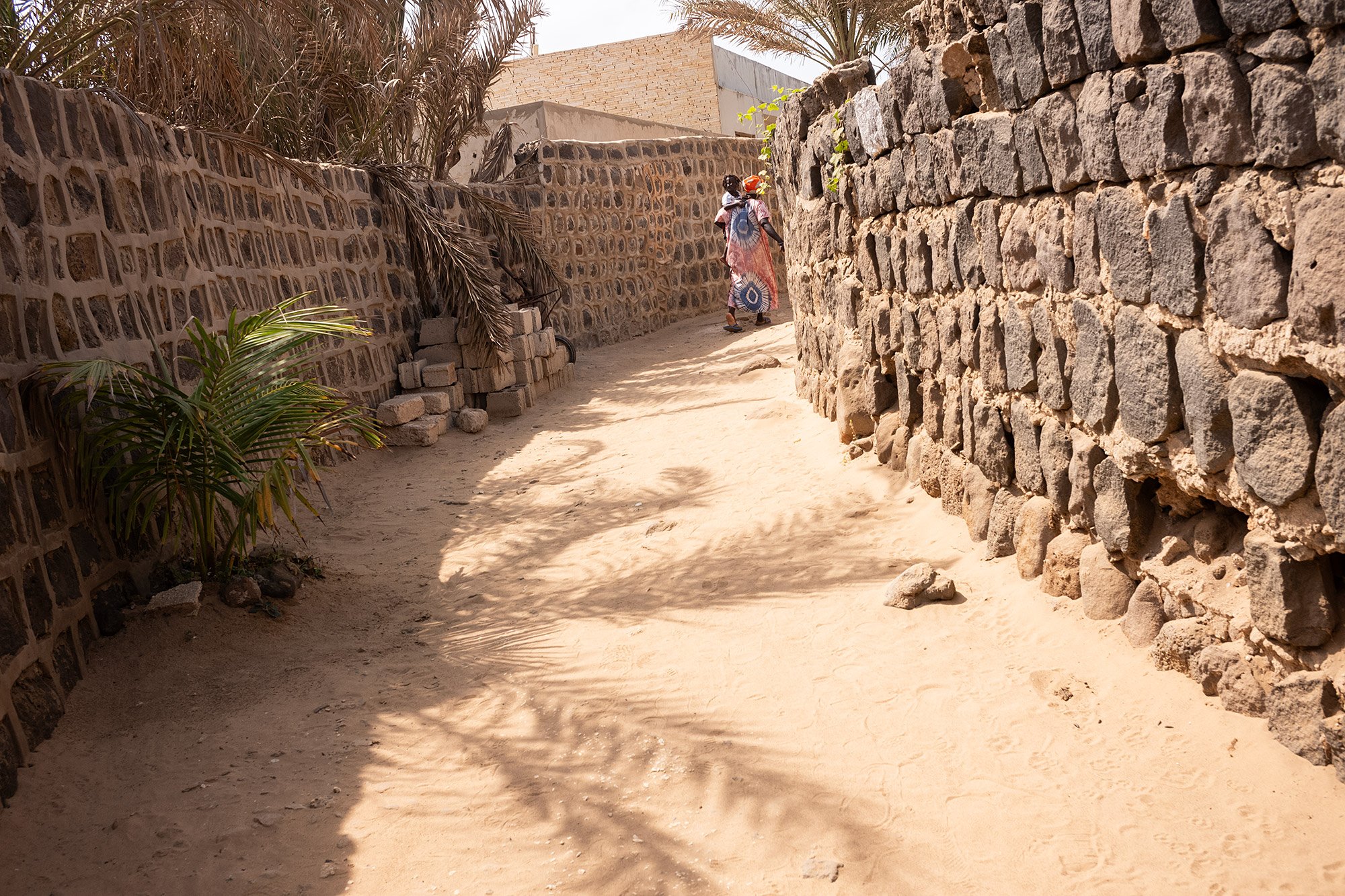
The ocean extends towards the horizon when I reach the edge of the island. A house sits on the corner and I gently circumambulate it on its pebbly foundation to reach the farthest end. What looks lke a diving board or an unloading dock is set up on a platform on the rocks, but the water before it seems too shallow for either and I am left wondering what function it provides.


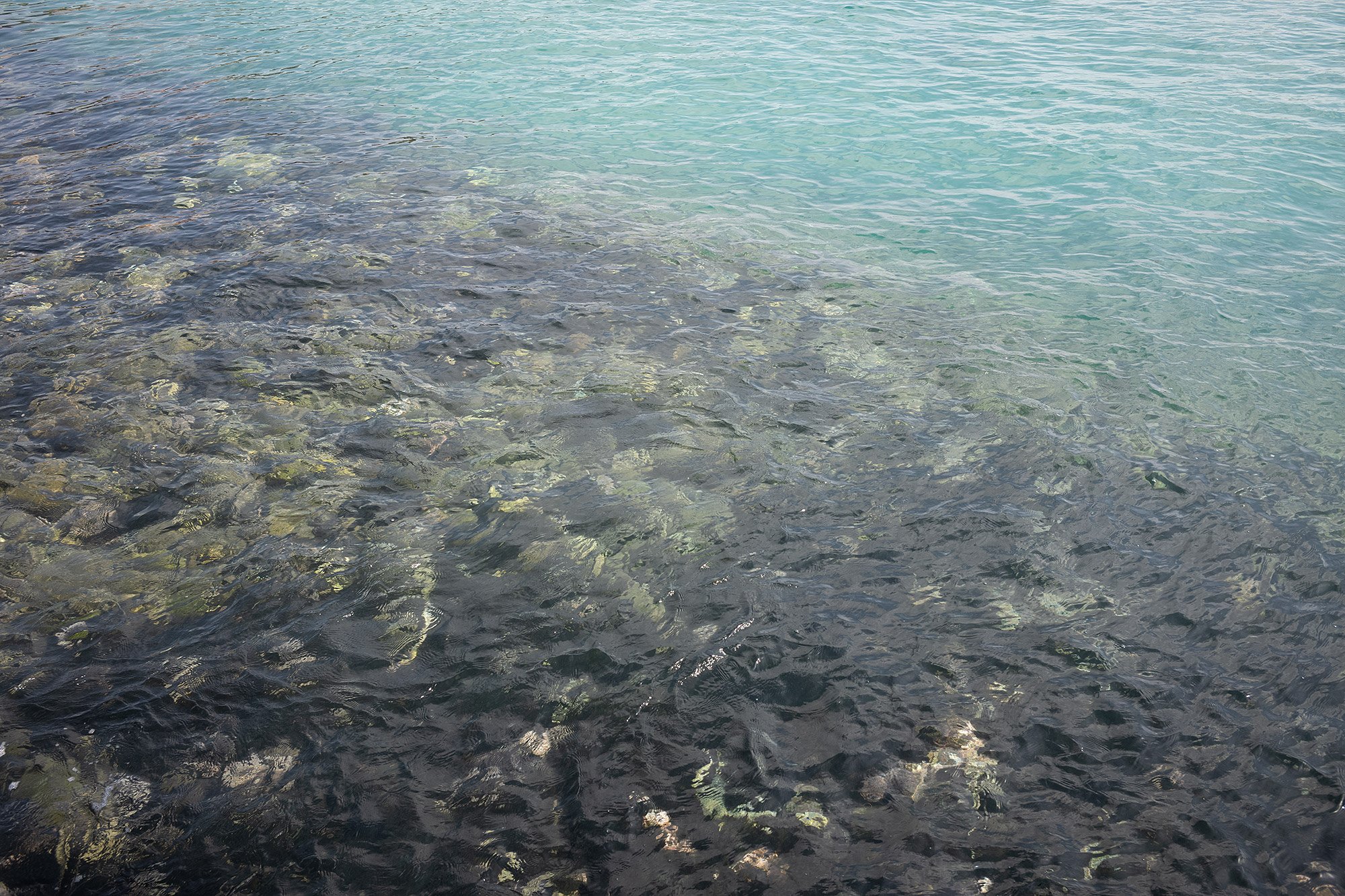

Coming back around a woman asks me to look at her shop. She has the usual array of bracelets and caps and shirts and sarongs, in African colors and patterns. There are colorful caps that I seem to remember adorning the heads of golden age hip hop stars. I’m tempted but decide not to add to my belongings at this time. She tells me there are many African Americans who come and buy. I thank her and head back towards town.
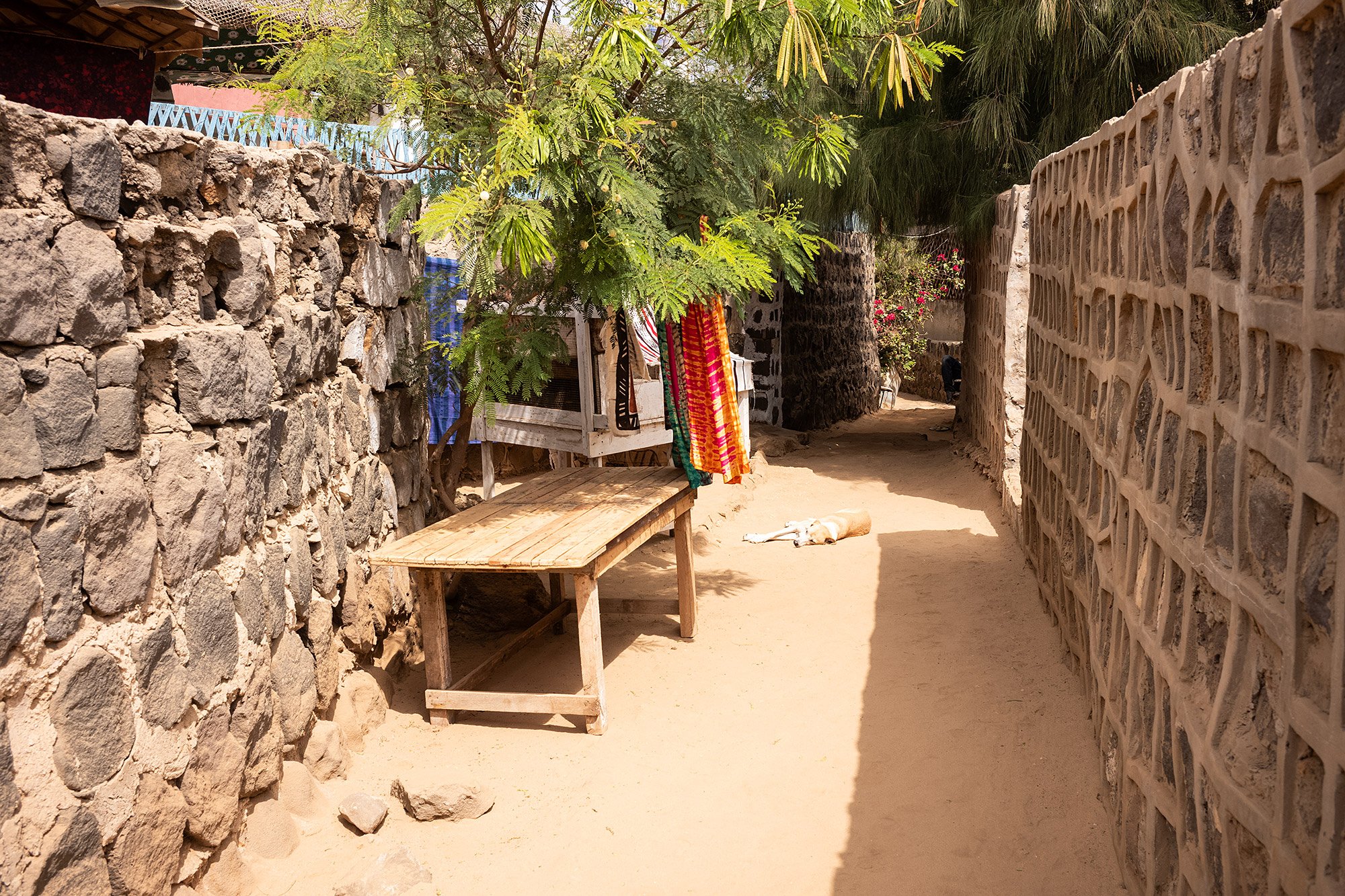


Looking down a narrow alley I see the sea to the north. I take the left and find a dirt path that runs along the outer edge of the settlements. I follow it, circumambulating the island for as long as I can, passing exercise aparatus that looks like it’s designed for a military obstacle course, cactus patches, guesthouses. Finally the path comes to an end and I follow another alley back towards the center.
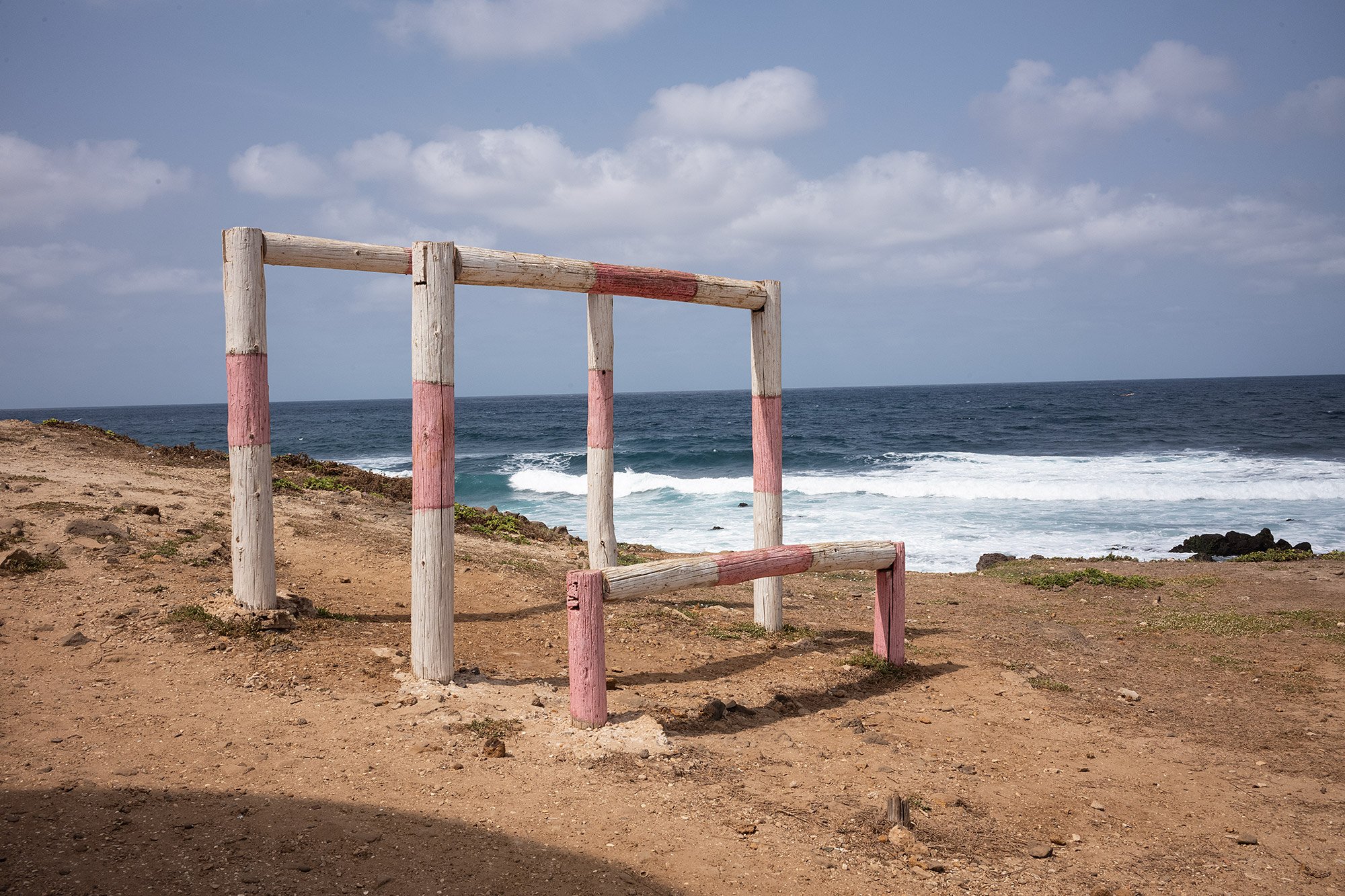
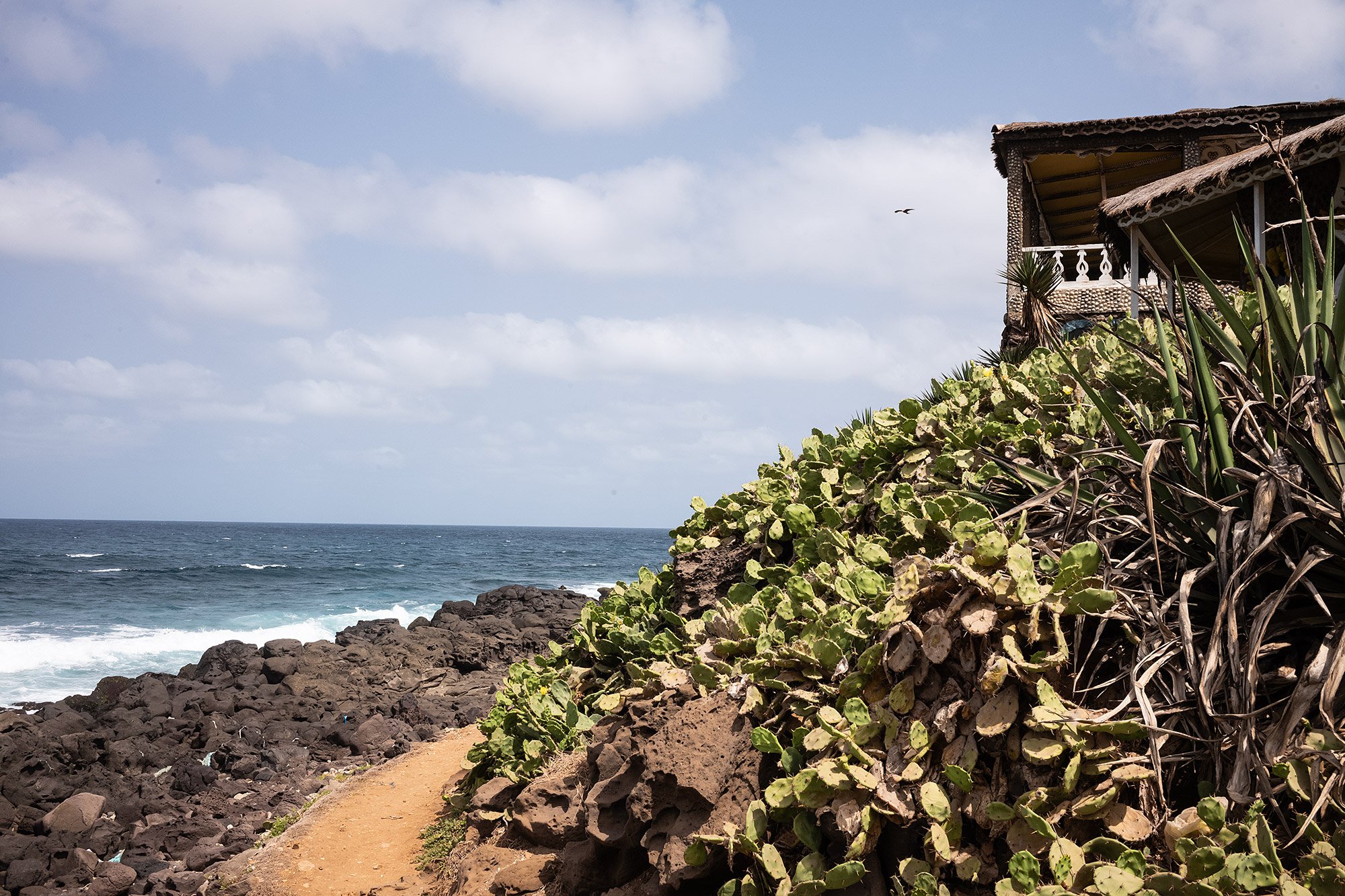
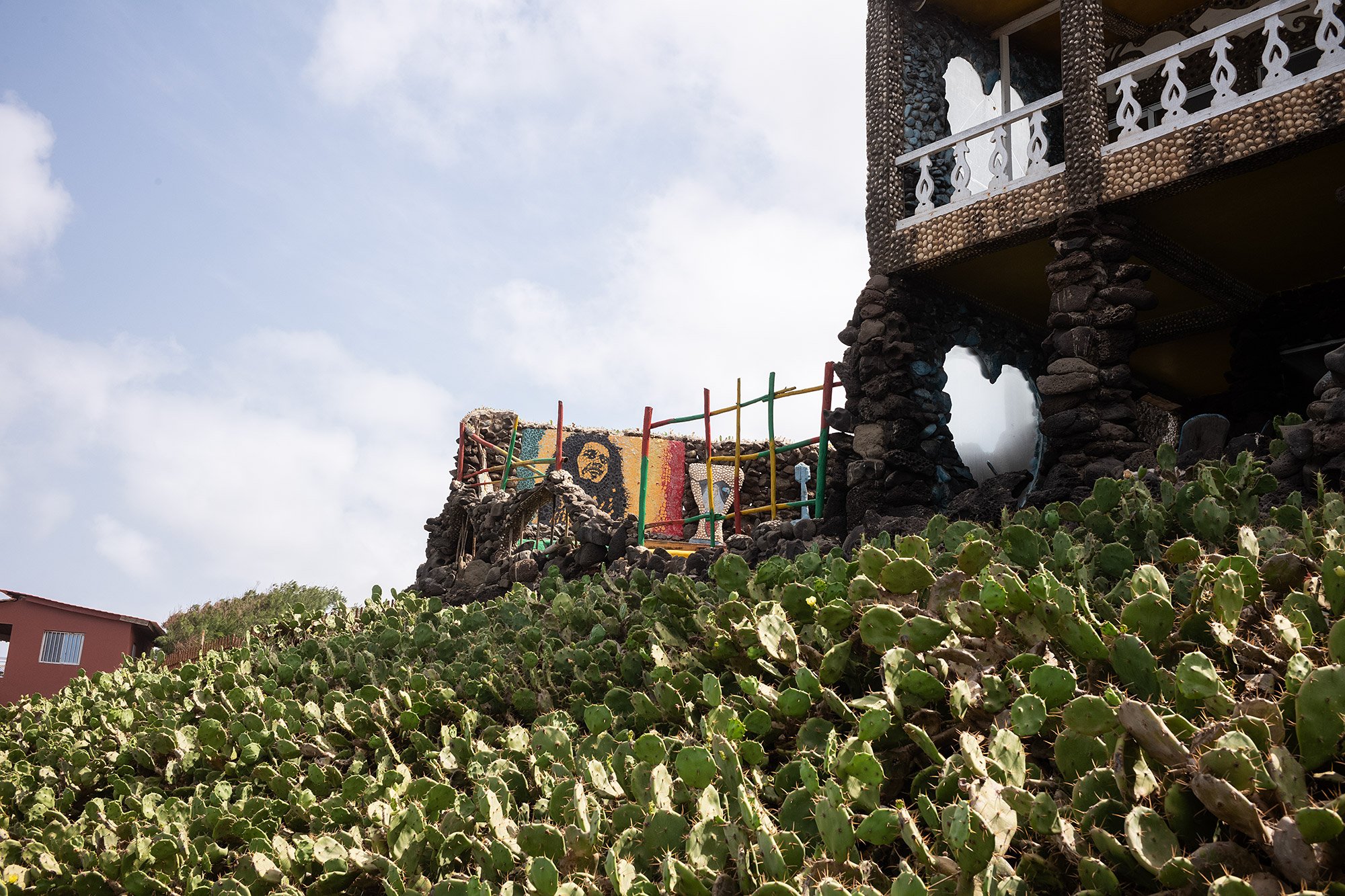
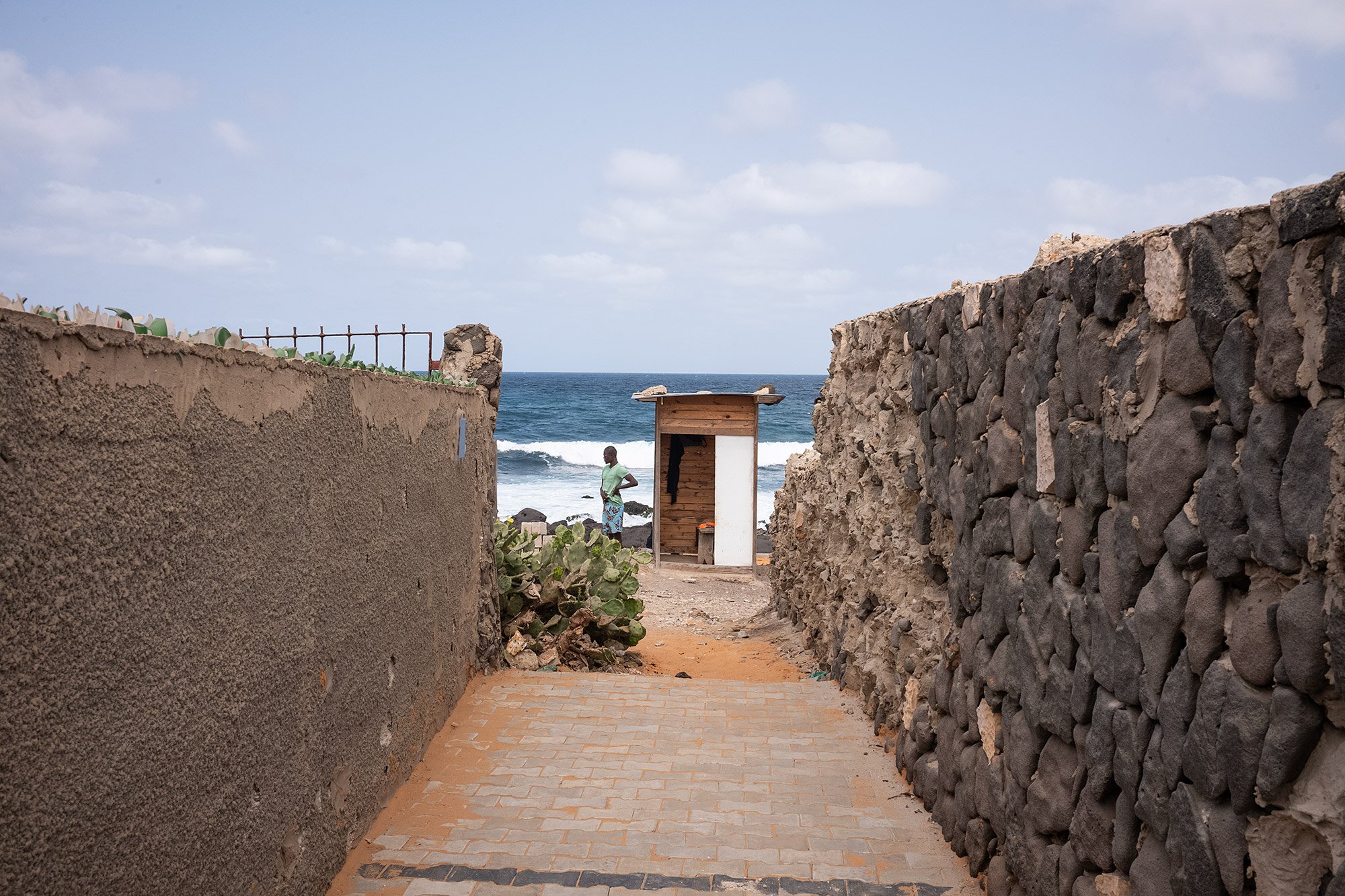
I wander the streets and alleys, finding one more path towards the northern coast. I walk past a local stand selling eggs and other necessities and a small restaurant from which I can hear and smell food frying. A painting of the African Renaissance Monument adorns one of its outer walls.
A man sits by the ocean. A small pool has been formed by a ring of rocks. The water is clear and shallow. I say hello and then leave him to his contemplations.


I continue to make photos of the streets and painted walls that make up the island. At one point a man looks curiously at what might have struck my interest. Les couleurs, I say. He looks thoughtful, nods, returns to his previous action.
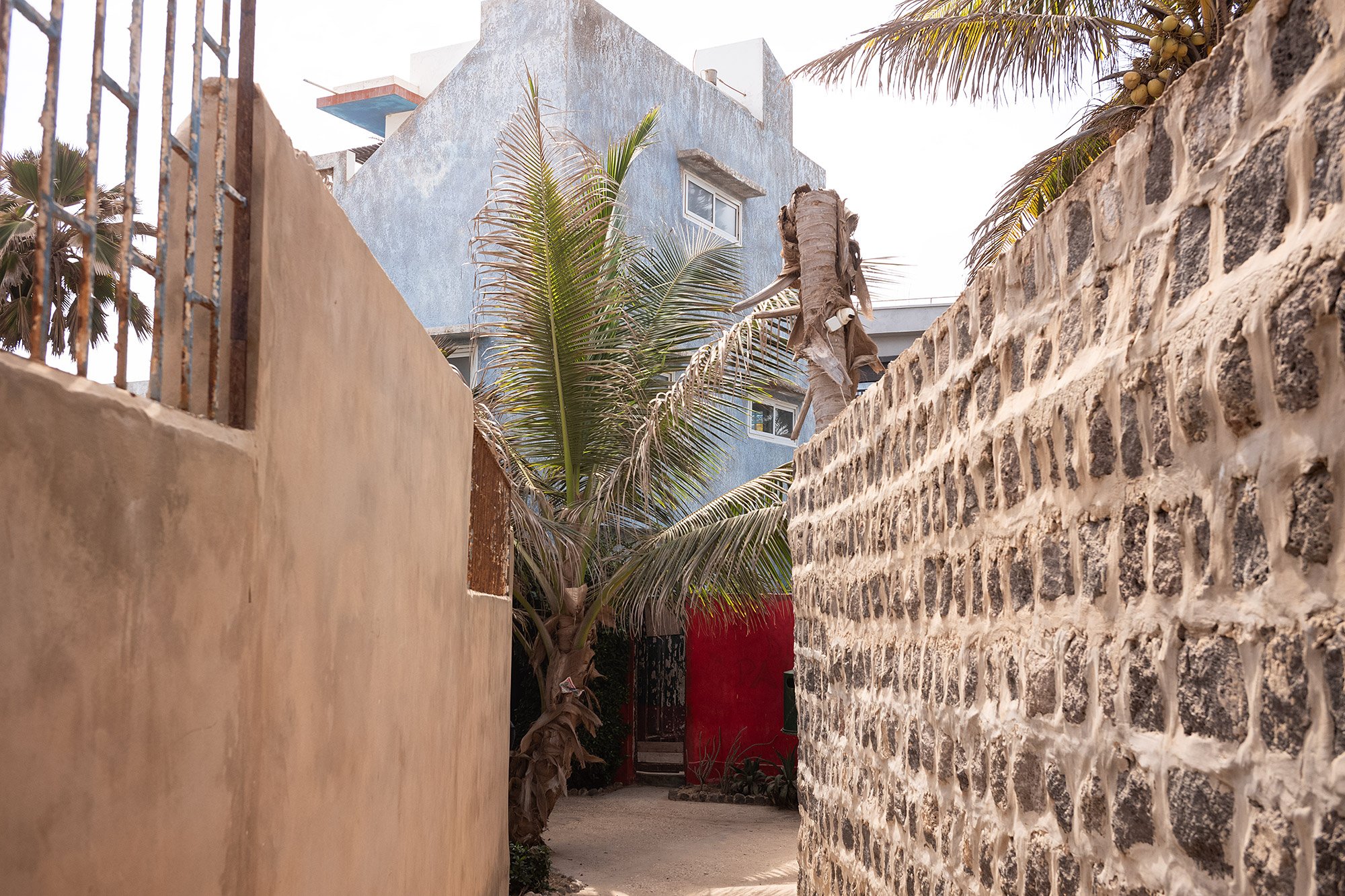

The path leads back to the main beach. I walk past all of the restaurants, telling the proprietors who approach me that I’m already committed to eat at a restaurant down the way. They recognize me and lead me to a table in the front with views of the water and of Dakar just across the strait.
I order the thiéboudieune, a local staple comprised of fish, rice, and vegetables. The waiter tells me it’ll take some time; it’s not done yet. I tell him I’m in no hurry and pull out my book, settling in to wait. After a few pages I can resist the waters no longer and strip down to my swim trunks to take a dip in the ocean. The cook assures me that the food will be ready soon. I tell her I won’t be long.
The water is cool and clean and I let myself fall into its embrace. Where I am it’s sandy but rocks loom around. The water is shallow, but deep enough to float in, and I do so, watching the activity on the shore as I am buyoed by the sea.
Back at the restaurant a mixed family has taken up all the remaining tables in the front. Three Italian women and three African men and their small children. It’s a huge group. Women walk by selling fruit juices, offer various wares. Men offer pedicures. They have them give one of their sons a pedicure. A saleswoman settles in beside them to share her bracelets, bandanas, bags, fabrics. She spends the entire lunch showing them wares and bargaining. I lose track of how many different items they’ve bought.
The food is delicious. I wish I knew of a restaurant near me that served thiéboudieune. I’d eat it two or three times a week. Small kittens mew at my feet, place their paws on my knee. I indulge them a few bites; they disappear as soon as I have finished.
The waiter asks if I would like coffee and I say yes. It’s equally delicious, served sweet with a smokey, hickory taste. I savor it as I watch the passenger boats pass between the island and the mainland, inferring their schedules.
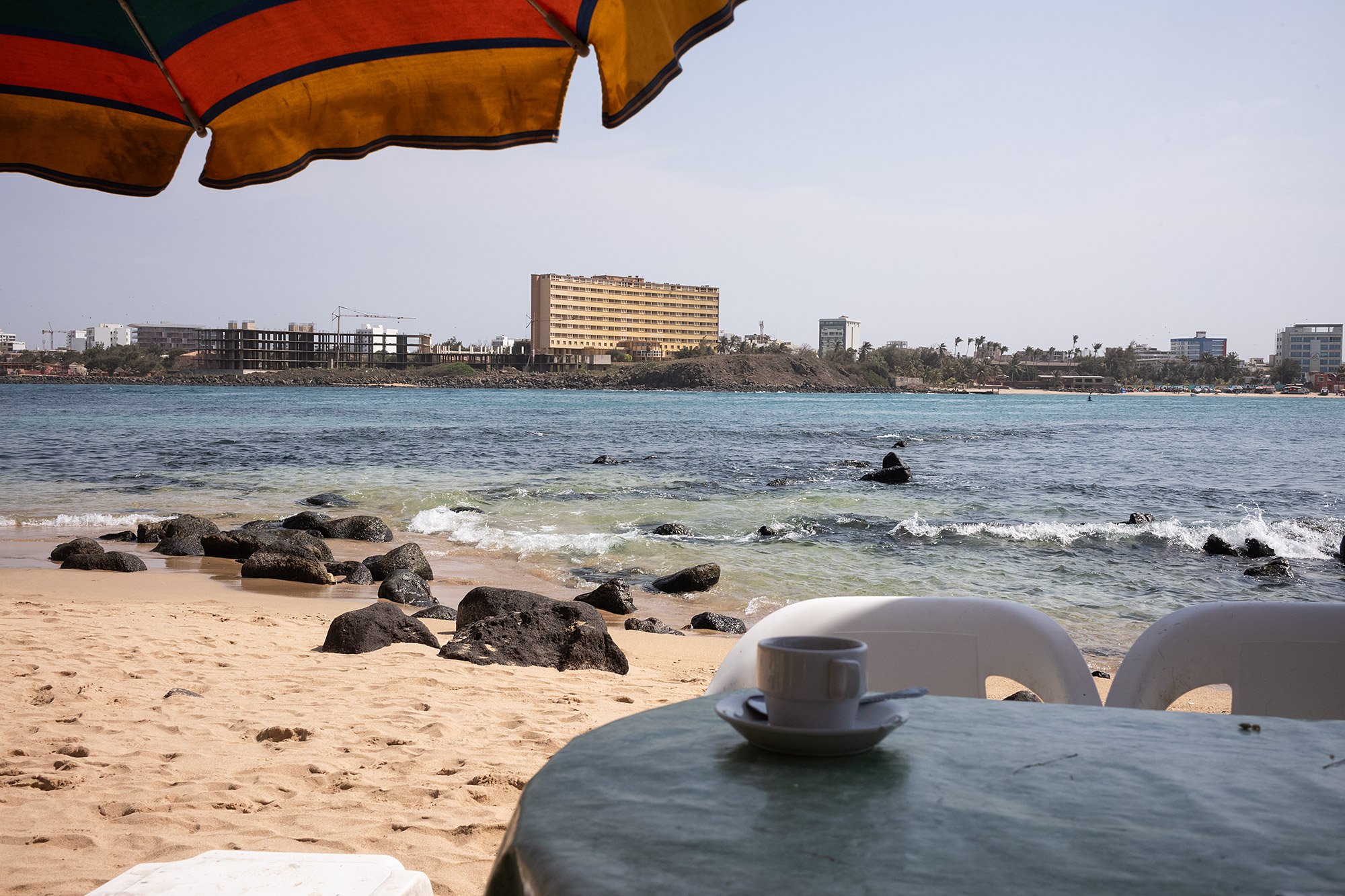
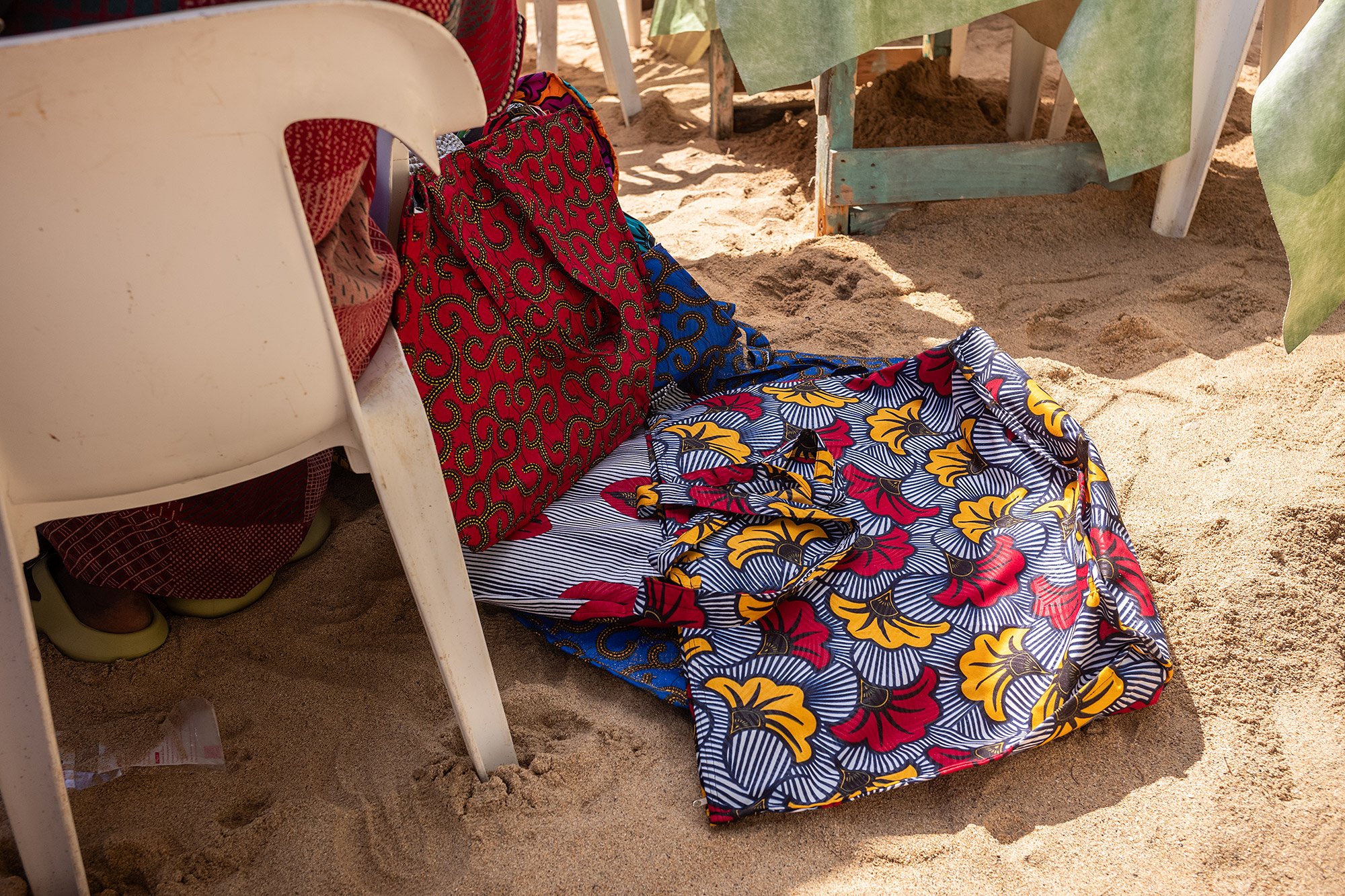
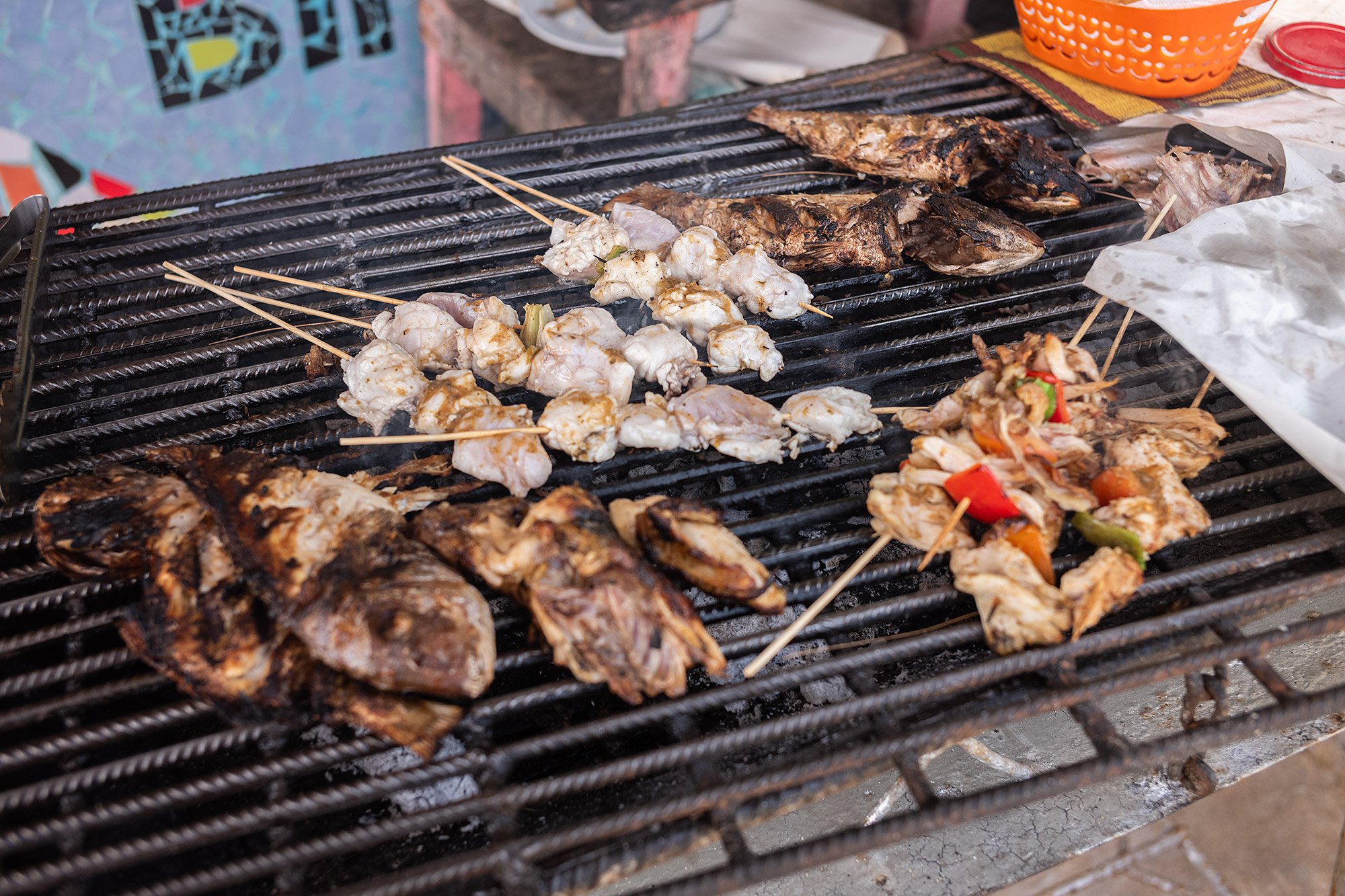
As the top of the hour approaches, I pay my bill. I watch as people board the local pirogue and start the quick journey to the island. I walk along the beach and reach the landing point at the same time as the boat.
Disembaring passengers hand their life jackets to those waiting to embark. I wade into the water and pull myself up into the boat. The captain waits only as long as it takes for the last passenger to board before pulling back into the strait. All in all it’s taken less than ten minutes.

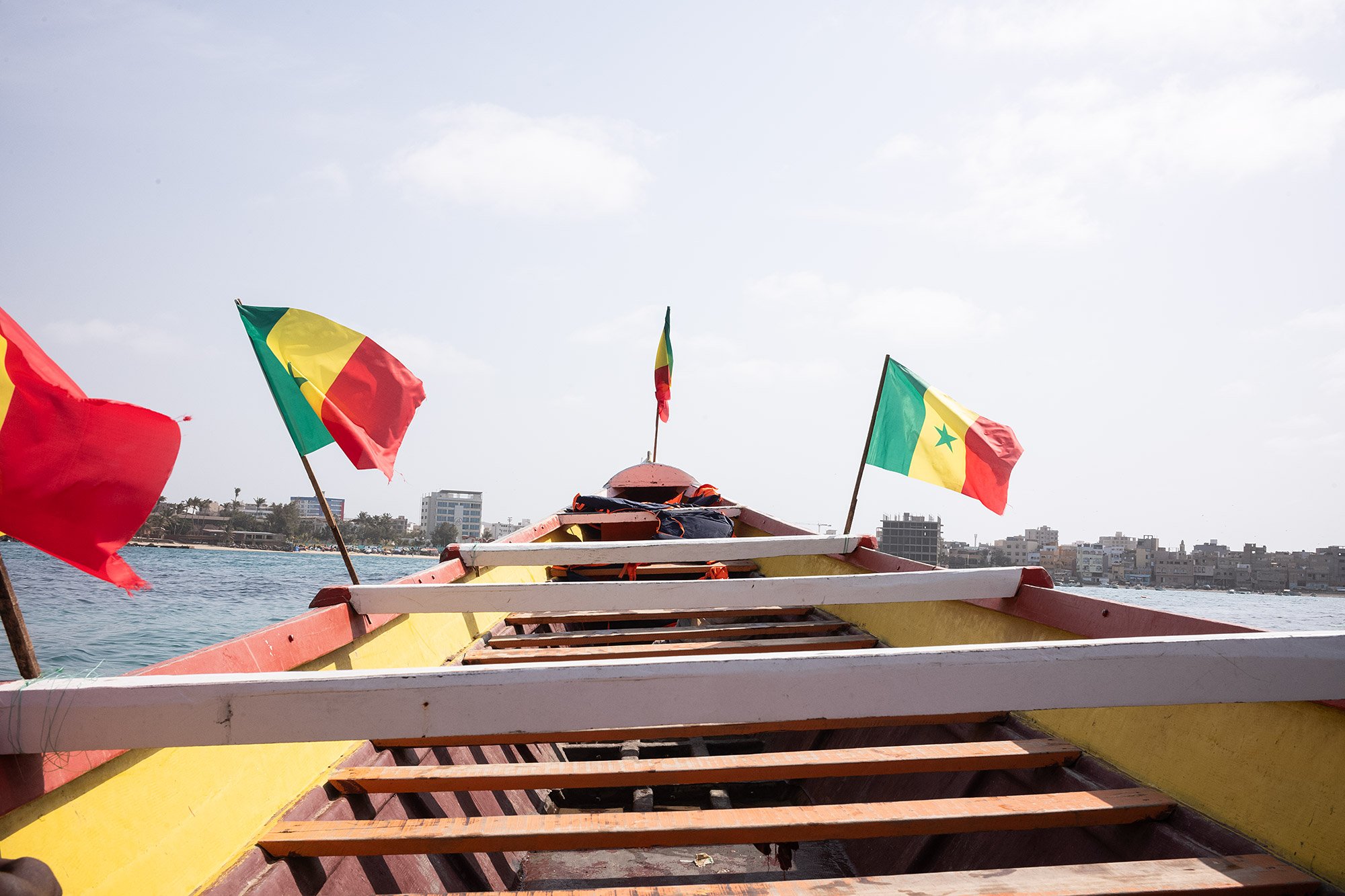
Back on the mainland a fisherman approaches. He tells me he had a good day. He’s caught a large barracuda. We chat as I watch children play in the surf. Birds continue to swoop overhead. He asks me if I want to go see it, see the market, but my mind is cast elsewhere. I thank him, but tell him that I’m going to head home.
As I walk away from the beach I see a group of children crowded around a TV set. Algeria is playing Burkina Faso in the Africa Cup of Nations. AFCON had started the weekend before while I was in The Gambia, and I’ve had the matches on all week. Yesterday, Senegal played Cameroon and I could hear cheers erupt every time the home team scored. Women danced on balconies, children celebrated in the street.
Senegal are the defending champions and expectations run high. Had I known I might have planned my trip around being in Senegal for the finals (or planned to follow up my trip to Senegal with one to Côte d'Ivoire where the matches are being played), but South America (and Antarctica) calls.
That said, I love my apartment in Dakar. In the mornings, hawks and other birds visit the balconies crying and chirping to me and their bretheren. On windy days, the rooms capture a cooling cross breeze. From the terrace I can see the light from the Phare des Mamelles if I stand just so. A new high rise under construction unfortunately blocks my view of the African Renaissance Monument. In the evenings, the sun sets behind the neighborhood mosque.
I’m already thinking about when I’ll be back in West Africa, and how I’ll incorporate a few days in Dakar on either end of the trip, if only to spend more time in this space. It’s one of my favorites.
20 January 2024
🇸🇳










